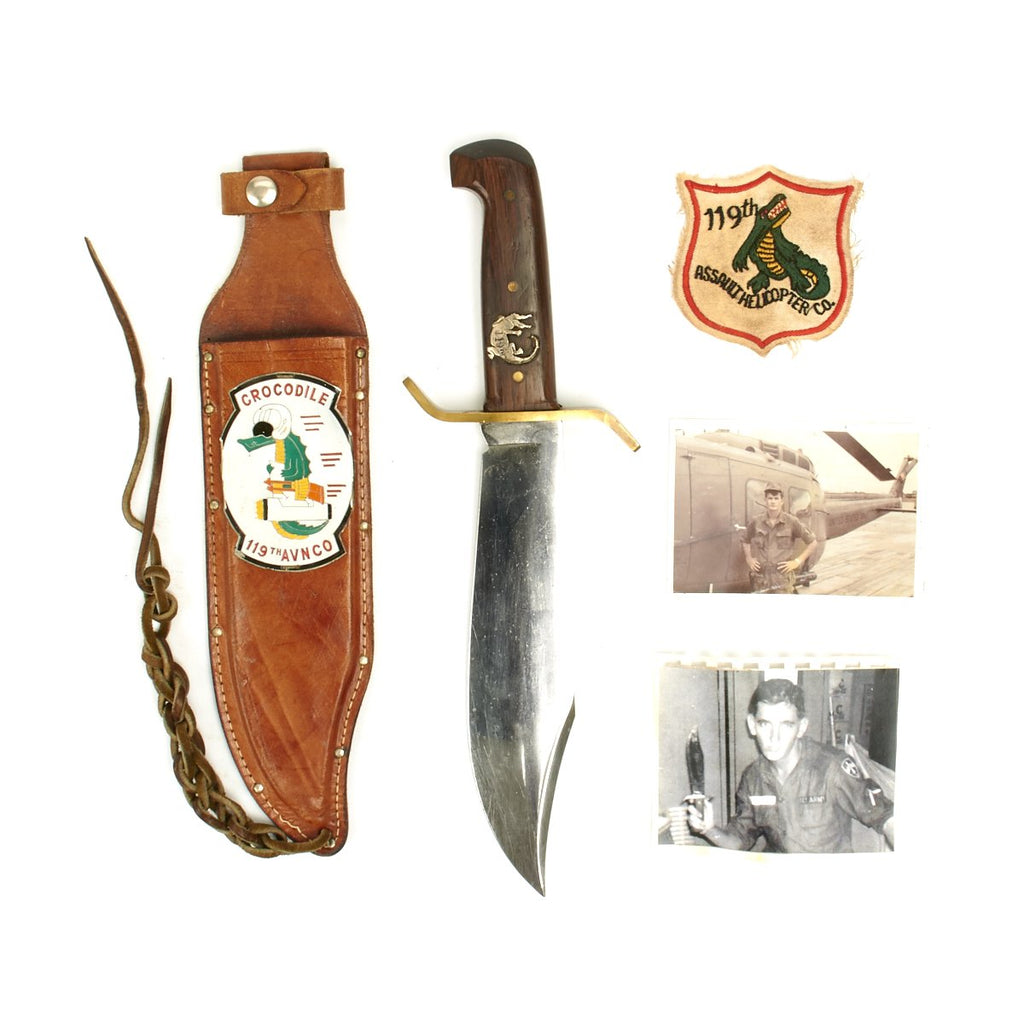-
Original Item: One-of-a-kind set. This is a fantastic grouping that belonged to a pilot in the 119th Assault Helicopter Company who flew during the Vietnam War. This grouping consists of the following:
Original Western Bowie USA knife with silver crocodile insignia embedded in grip. 9.25 blade, 14.5 overall length.
Original Matching leather sheath with large CROCODILE 119th AVNCO shield.
Original 119th Assault Helicopter Company patch.
2 x original photos of pilot with his Helicopter and him holding this very knife.
During the Vietnam War, one unit assigned to the 52nd Combat Aviation Battalion, 17th Combat Aviation Group, 1st Aviation Brigade was the 119th Assault Helicopter Company. The company operated throughout the Central Highlands of Vietnam during the war, from arrival in September 1962 until deactivation in November 1970. Originally designated the 81st Transportation Company (equipped with twin-rotor CH-21 "Flying Banana" piston-engined helicopters), the company was reorganized in 1963 as the 119th Assault Helicopter Company (Airmobile), re-equipped with turbine-powered single-rotor UH-1A and B model Hueys. Also known as the 119th Aviation Company (Assault Helicopter), the company's area of operations included the entire Central Highlands of Vietnam, plus large portions of Laos and Cambodia.
Eventually assigned to the 52nd Combat Aviation Battalion, 17th Combat Aviation Group, 1st Aviation Brigade and headquartered at Camp Holloway in Pleiku, the company was also based at An Khe for a short time from late in 1969 to 1970. The unit was attacked twice by NVA sappers while in An Khe, once in each year. The Company was equipped with 16 to 20 lightly armed UH-1 slicks, and by 1969 all UH-1Ds were upgraded to more-powerful UH-1H models and approximately 8 Huey UH-1C model Gunships. The "slick" troopships used the radio callsign "Alligator" or "Gator", the gunships used the callsign "Crocodiles" or "Crocs". The callsigns that the pilots used were atypical for US Army aviation units of the time, instead of standard callsigns such as "Blue four-one" or "Yellow six," the pilots used nicknames. Some nicknames were contemporary for the time, and others were semi-obscene. The company at one time also used the callsign called "Black Dragon," from which the 52nd CABn "Flying Dragon" callsign evolved. The total company strength of approximately 225 included 50 to 60 pilots and an equal number of crewmembers, plus field maintenance and other critical support personnel.
During over eight years in Vietnam, the 119th Assault Helicopter Company provided helicopter support for the US Army 4th Infantry Division, 25th Infantry Division, 1st Cavalry Division, 173d Airborne Brigade, US Marine Corps, United States Army Special Forces and the Army of the Republic of Vietnam. They also flew many classified missions for MACV-SOG. Over 60 members of the 119th Assault Helicopter Company were killed in action, with many more wounded.
The Bell AH-1 Cobra is a two-blade, single-engine attack helicopter manufactured by Bell Helicopter. It was developed using the engine, transmission and rotor system of the Bell UH-1 Iroquois. A member of the prolific Huey family, the AH-1 is also referred to as the HueyCobra or Snake.
The AH-1 was the backbone of the United States Army's attack helicopter fleet, but has been replaced by the AH-64 Apache in Army service. Upgraded versions continue to fly with the militaries of several other nations. The AH-1 twin engine versions remain in service with United States Marine Corps (USMC) as the service's primary attack helicopter.
By June 1967, the first AH-1G HueyCobras had been delivered. Originally designated as UH-1H, the "A" for attack designation was soon adopted and when the improved UH-1D became the UH-1H, the HueyCobra became the AH-1G. The AH-1 was initially considered a variant of the H-1 line, resulting in the G series letter.
AH-1 Cobras were in use by the Army during the Tet offensive in 1968 and through to the end of the Vietnam War. Cobras provided fire support for ground forces, escorted transport helicopters and other roles, including aerial rocket artillery (ARA) battalions in the two Airmobile divisions. They also formed "hunter killer" teams by pairing with OH-6A scout helicopters. A team featured one OH-6 flying slow and low to find enemy forces. If the OH-6 drew fire, the Cobra could strike at the then revealed enemy. On 12 September 1968, Capt. Ronald Fogleman was flying an F-100 Super Sabre when the aircraft was shot down and he ejected 200 miles north of Bien Hoa. Fogleman became the only pilot to be rescued by holding on to an Army AH-1G's deployed gun-panel door. Bell built 1,116 AH-1Gs for the U.S. Army between 1967 and 1973, and the Cobras chalked up over a million operational hours in Vietnam; the number of Cobras in service peaked at 1,081. Out of nearly 1,110 AH-1s delivered from 1967 to 1973 approximately 300 were lost to combat and accidents during the war. The U.S. Marine Corps used AH-1G Cobras in Vietnam for a short time before acquiring twin-engine AH-1J Cobras.
- This product is available for international shipping.
- Eligible for all payments - Visa, Mastercard, Discover, AMEX, Paypal & Sezzle


We Buy Military Antiques
Our team expert buyers travels the world to pay fair prices for entire estate collections to singular items.
START SELLING TODAY























